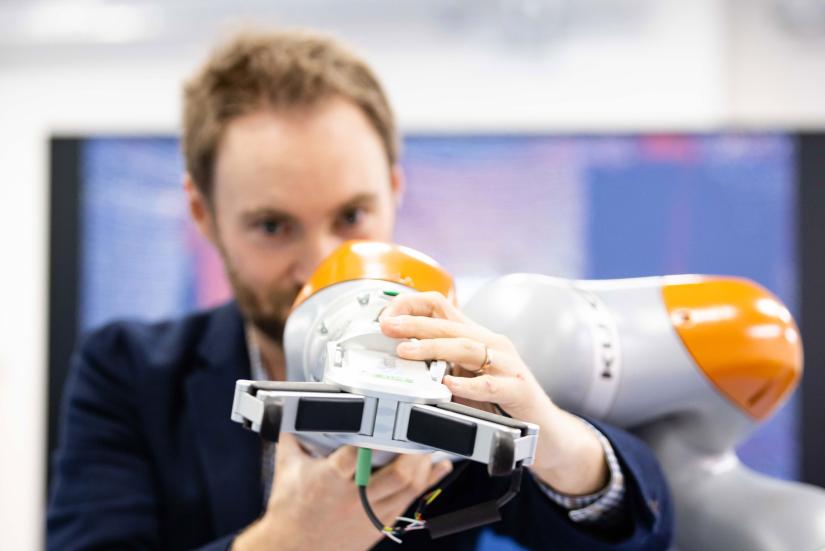By 2030, up to 800 million jobs could be displaced by automation. At this point, it’s not a question of if the robots will arrive in your workplace, but when.
But if you look at the stats more closely, they contain some good news, too. Rather than making jobs obsolete, robots are set to make certain tasks obsolete. Instead of being unemployed, you might find yourself working in partnership with a new colleague: a cobot.
Cobots (collaborative robots) are a lightweight, multi-purpose breed of robot that can work closely — and safely — with people. To do so, they need certain capabilities that make them useful in human environments — things like sensing their surroundings, navigating through space, and responding to humans in intuitive ways such as via voice commands or hand gestures.
But, as cobots take on increasingly sophisticated tasks, they require greater amounts of computational power that their onboard systems can’t always support.
“If our cobot is a mobile robot that runs off batteries, for example, there are limits to the additional processing power we can add to it, and therefore limits to what it can do and how long it can do it for,” says UTS Robotics Institute researcher Dr Marc Carmichael.
This challenge formed the basis of a research partnership between the UTS Robotics Institute and telecommunications company Nokia. Together, the two institutions investigated a novel solution to increase the capability of cobots through the use of 5G.
Small robots, big data
Funded by the previous Federal Government’s 5G Innovation Initiative and conducted in the Nokia 5G Futures Lab at the UTS Tech Lab facility, the research was based on two cobots: a robotic arm designed for pick and place operations that can work collaboratively next to humans and Spot, a robot dog that can explore human environments.
The research teams equipped both cobots with a range of sensors, including a high-resolution 360-degree camera and LIDARs similar to those used on autonomous cars. Armed with these technologies, the cobots collected vast volumes of data about their surroundings, including their proximity to humans.
“The addition of these technologies made our cobots go from relatively simple, not very capable systems to robots that generated a lot of data which could be used to make the systems smarter,” Dr Carmichael says.
Next, the researchers attached a 5G modem to each cobot, giving them the capability to offload their data via the modem over an onsite Private 5G network to a nearby network-edge computer. Here, the data could be processed and the appropriate instructions sent back to the cobot for real-time control.
“It was literally replacing a wired connection with a wireless one, and then see how that would impact the performance of the systems and how much data throughput we could get,” Dr Carmichael says.
The outcomes revealed novel insights into the cobots’ activities and how their capabilities changed as their computational power increased.
Crucially, the project demonstrated that cobots can successfully transfer significant volumes of data via a 5G network, resulting in tangible improvements for the system, including a 44 per cent increase in battery life for Spot the robot dog.
These findings demonstrate how 5G might be integrated into other robotics applications in the future, including drones, field robotics, health care and more, by freeing up computational bandwidth to increase the amount of data that these machines can transmit, receive and process.
Cobots need bigger brains, better senses, more information about the world to be able to understand what’s around them to make better decisions.
- Dr Marc Carmichael
A new tech pathway that could transform the cobotics field
The work also revealed a series of opportunities for Nokia to continue refining their 5G technologies in order to make them more tailored for future robotics applications.
“Initial constraints in throughput and latency led to some reduction in end-to-end performance compared to wired connections,” says Dr Robert Joyce, Chief Technology Officer for Nokia in Australia & New Zealand.
“However, it has been shown that increased throughput requirements can be achieved by 5G, and further, cobots are expected to be connected across the upgraded Nokia 5G mmWave private network in the near future.”
It’s a new horizon in the world of cobots, and it offers exciting — and as-yet-untapped — opportunity.
“Cobots need bigger brains, better senses, more information about the world to be able to understand what’s around them to make better decisions,” Dr Carmichael says.
“That’s where we need better computational resources, we need communications infrastructure, and there’s where 5G is a useful tool.”


